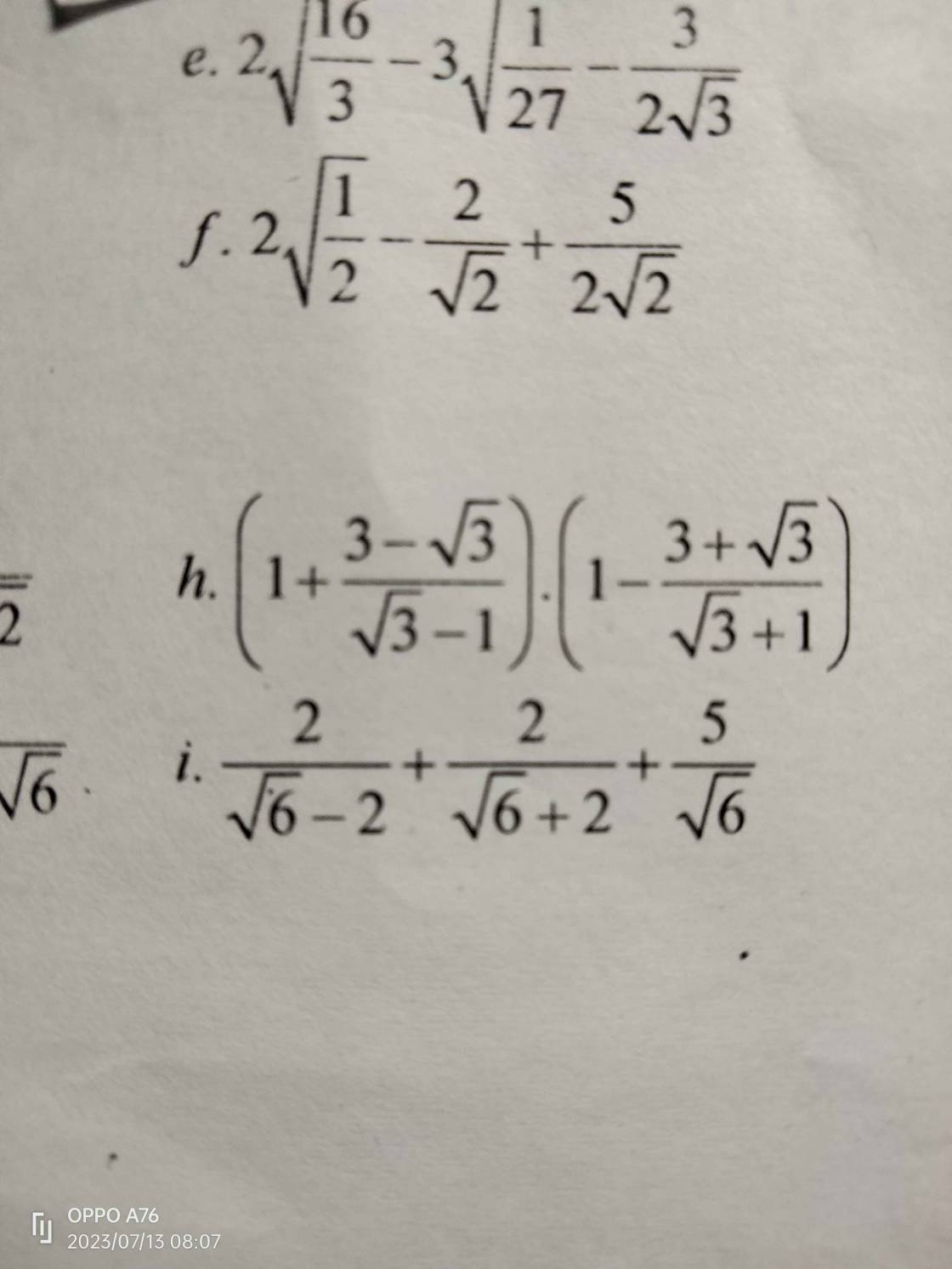Hãy nhập câu hỏi của bạn vào đây, nếu là tài khoản VIP, bạn sẽ được ưu tiên trả lời.

2\(\sqrt{\dfrac{16}{3}}\) - 3\(\sqrt{\dfrac{1}{27}}\) - \(\dfrac{3}{2\sqrt{3}}\)
= \(\dfrac{8}{\sqrt{3}}\) - \(\dfrac{3}{3\sqrt{3}}\) - \(\dfrac{3}{2\sqrt{3}}\)
= \(\dfrac{8}{\sqrt{3}}\) - \(\dfrac{1}{\sqrt{3}}\) - \(\dfrac{3}{2\sqrt{3}}\)
= \(\dfrac{16}{2\sqrt{3}}\) - \(\dfrac{2}{2\sqrt{3}}\) - \(\dfrac{3}{2\sqrt{3}}\)
= \(\dfrac{11}{2\sqrt{3}}\)
= \(\dfrac{11\sqrt{3}}{6}\)
f, 2\(\sqrt{\dfrac{1}{2}}\)- \(\dfrac{2}{\sqrt{2}}\) + \(\dfrac{5}{2\sqrt{2}}\)
= \(\dfrac{2}{\sqrt{2}}\) - \(\dfrac{2}{\sqrt{2}}\) + \(\dfrac{5}{2\sqrt{2}}\)
= \(\dfrac{5}{2\sqrt{2}}\)
= \(\dfrac{5\sqrt{2}}{4}\)
(1 + \(\dfrac{3-\sqrt{3}}{\sqrt{3}-1}\)).(1- \(\dfrac{3+\sqrt{3}}{\sqrt{3}+1}\))
= \(\dfrac{\sqrt{3}-1+3-\sqrt{3}}{\sqrt{3}-1}\).\(\dfrac{\sqrt{3}+1-3+\sqrt{3}}{\sqrt{3}+1}\)
= \(\dfrac{2}{\sqrt{3}-1}\).\(\dfrac{-2}{\sqrt{3}+1}\)
= \(\dfrac{-4}{3-1}\)
= \(\dfrac{-4}{2}\)
= -2

ĐKXĐ:\(x>-3\)
\(\sqrt{x}+\sqrt{x+3}=x+4\)\(\Leftrightarrow x+x+3+2\sqrt{x}\sqrt{x+3}=\left(x+4\right)^2\)
\(\Leftrightarrow2x+3+2\sqrt{x^2+3x}=x^2+8x+16\)
\(\Leftrightarrow x^2+8x+16-2x-3-2\sqrt{x^2+3x}=0\)
\(\Leftrightarrow\left(x^2+3x-2\sqrt{x^2+3x}+1\right)+3x+12=0\)
\(\Leftrightarrow\left(\sqrt{x^2+3x}-1\right)^2+3\left(x+4\right)=0\)
Ta thấy:\(\hept{\begin{cases}\left(\sqrt{x^2+3x}-1\right)^2\ge0\\x>-3\Leftrightarrow3\left(x+4\right)>0\end{cases}}\)
\(\Rightarrow\left(\sqrt{x^2+3x}-1\right)^2+3\left(x+4\right)>0\)
\(\Leftrightarrow x\in\varnothing\)
Vậy phương trình vô nghiệm.

Em dùng công thức toán học hoặc viết ra giấy, chụp ảnh rồi up lên chứ thế này cô không đúng đề bài để giúp em được.

ĐKXĐ : \(x>0\)
Áp dụng bất đẳng thức Cauchy cho 2 số dương \(\sqrt{x};\dfrac{4}{\sqrt{x}}\) ta có
\(P=\sqrt{x}+\dfrac{4}{\sqrt{x}}\ge2\sqrt{\sqrt{x}.\dfrac{4}{\sqrt{x}}}=4\)
Dấu "=" xảy ra khi \(\sqrt{x}=\dfrac{4}{\sqrt{x}}\Leftrightarrow x=4\)
\(P=\sqrt[]{x}+\dfrac{4}{\sqrt[]{x}}\left(x>0\right)\)
\(P=\dfrac{x+4}{\sqrt[]{x}}=\dfrac{x+4}{\sqrt[]{x}}\)
Vì \(x>0;x+4>4\)
\(\Rightarrow P=\dfrac{x+4}{\sqrt[]{x}}>4\)
⇒ Không có giá trị nhỏ nhất

đk: \(x\ge0\)
Ta có: \(\sqrt{x}+2\sqrt{x+3}=x+4\)
\(\Leftrightarrow\left(x+3\right)-2\sqrt{x+3}+1=\sqrt{x}-1\)
\(\Leftrightarrow\sqrt{\left(\sqrt{x-3}-1\right)^2}=\sqrt{x}-1\)
\(\Leftrightarrow\left|\sqrt{x-3}-1\right|=\sqrt{x}-1\)
\(\Leftrightarrow\orbr{\begin{cases}\sqrt{x-3}-1=\sqrt{x}-1\\\sqrt{x-3}-1=1-\sqrt{x}\end{cases}}\)
\(\Leftrightarrow\orbr{\begin{cases}\sqrt{x-3}=\sqrt{x}\left(ktm\right)\\\sqrt{x-3}+\sqrt{x}=2\end{cases}}\)
\(\Leftrightarrow x-3+x+2\sqrt{x\left(x-3\right)}=4\)
\(\Leftrightarrow2\sqrt{x^2-3x}=7-2x\)
\(\Leftrightarrow4\left(x^2-3x\right)=\left(7-2x\right)^2\)
\(\Leftrightarrow4x^2-12x=49-28x+4x^2\)
\(\Leftrightarrow16x=49\)
\(\Rightarrow x=\frac{49}{16}\)

\(\sqrt{x}+\sqrt{1-x}\)
\(=\dfrac{x+1-x}{\sqrt{x}-\sqrt{1-x}}=\dfrac{1}{\sqrt{x}-\sqrt{1-x}}\)
